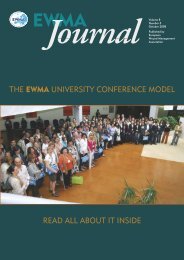best practice for the management of lymphoedema ... - EWMA
best practice for the management of lymphoedema ... - EWMA
best practice for the management of lymphoedema ... - EWMA
You also want an ePaper? Increase the reach of your titles
YUMPU automatically turns print PDFs into web optimized ePapers that Google loves.
LOWER LIMB LYMPHOEDEMA –<br />
INITIAL MANAGEMENT<br />
Initial <strong>management</strong> <strong>of</strong> lower limb<br />
<strong>lymphoedema</strong> will involve psychosocial<br />
support, education, skin care,<br />
exercise/movement, elevation and<br />
<strong>management</strong> <strong>of</strong> any concomitant medical<br />
conditions, pain or discom<strong>for</strong>t (Figure 6).<br />
The patient's initial <strong>management</strong> may also<br />
include:<br />
■ compression hosiery<br />
■ modified MLLB<br />
■ intensive <strong>the</strong>rapy.<br />
Compression hosiery<br />
Patients with mild lower limb <strong>lymphoedema</strong><br />
(ISL stage I), minor pitting, no significant<br />
tissue changes, no or minimal shape<br />
distortion, or palliative needs may be<br />
suitable <strong>for</strong> initial <strong>management</strong> with<br />
compression hosiery. The pressure used<br />
should be guided by <strong>the</strong> patient's vascular<br />
status and <strong>the</strong>ir ability to tolerate<br />
compression and manage <strong>the</strong> garment<br />
(pages 39-45). Skin care,<br />
exercise/movement, elevation and SLD<br />
should be taught alongside self monitoring<br />
and proper application, removal and care <strong>of</strong><br />
hosiery. Patients' application/removal<br />
technique should be assessed and<br />
monitored.<br />
Patients should be reviewed four to six<br />
weeks after initial fitting, and <strong>the</strong>n after<br />
three to six months if response is<br />
satisfactory. The patient should be reviewed<br />
at each garment renewal, ie approximately<br />
every three to six months.<br />
The practitioner will be appropriately<br />
trained.<br />
Modified MLLB<br />
Patients with ISL stage II or late stage II<br />
lower limb <strong>lymphoedema</strong> may be<br />
candidates <strong>for</strong> initial treatment with<br />
modified MLLB, outside an intensive <strong>the</strong>rapy<br />
regimen. Modified MLLB may also be useful<br />
in controlling symptoms in patients with<br />
cancer-related <strong>lymphoedema</strong> and frail<br />
patients who have complex medical<br />
problems (page 34). Management should<br />
include skin care, exercise/movement,<br />
elevation, SLD and psychosocial support.<br />
The practitioner will be appropriately<br />
trained.<br />
Intensive <strong>the</strong>rapy<br />
Intensive <strong>the</strong>rapy reduces swelling by<br />
decongesting impaired lymphatic pathways,<br />
reducing lymphatic load, encouraging <strong>the</strong><br />
development <strong>of</strong> collateral drainage routes,<br />
and stimulating <strong>the</strong> function <strong>of</strong> remaining<br />
patent routes.<br />
Intensive <strong>the</strong>rapy is used in patients with<br />
ISL stage II, late stage II and stage III lower<br />
limb <strong>lymphoedema</strong>. Intensive <strong>the</strong>rapy<br />
regimens use a combination <strong>of</strong> skin care,<br />
MLLB, exercise/movement and elevation.<br />
The regimen may include MLD or MLD<br />
with IPC.<br />
The frequency <strong>of</strong> treatment, degree <strong>of</strong><br />
compression and type <strong>of</strong> bandaging used<br />
should be adapted according to <strong>the</strong> patient's<br />
physical and psychosocial needs, and to <strong>the</strong><br />
presence <strong>of</strong> venous ulceration and arterial or<br />
venous insufficiency (Figure 7, page 19).<br />
Intensive <strong>the</strong>rapy programmes are likely<br />
to be undertaken <strong>for</strong> a period <strong>of</strong> two to four<br />
weeks, although a maximal effect may be<br />
achieved more quickly in some patients.<br />
During this time treatment should be<br />
evaluated continuously and appropriate<br />
alterations made according to patient need<br />
and <strong>the</strong> effectiveness <strong>of</strong> <strong>the</strong> selected<br />
regimen. Appropriate training is required <strong>for</strong><br />
all practitioners who deliver intensive<br />
<strong>the</strong>rapy programmes 49 .<br />
Standard intensive <strong>the</strong>rapy (>45mmHg)<br />
This involves skin care, exercise/movement,<br />
elevation, MLD, and MLLB with inelastic<br />
bandages (sub-bandage pressure<br />
>45mmHg) undertaken daily.<br />
Patients undergoing standard intensive<br />
<strong>the</strong>rapy must be carefully selected and be<br />
willing and able to commit physically and<br />
emotionally to daily intensive <strong>the</strong>rapy,<br />
including participation in exercise<br />
programmes.<br />
The practitioner will be appropriately<br />
trained at specialist level.<br />
TREATMENT<br />
DECISIONS<br />
INTENSIVE THERAPY<br />
The combination <strong>of</strong> skin<br />
care, exercise, MLD and<br />
MLLB is <strong>of</strong>ten known as<br />
decongestive lymphatic<br />
<strong>the</strong>rapy (DLT) or complete<br />
decongestive <strong>the</strong>rapy<br />
(CDT). The term intensive<br />
<strong>the</strong>rapy has been used in<br />
this document to denote a<br />
holistic approach that<br />
includes education,<br />
psychosocial support and<br />
pain <strong>management</strong>, and<br />
that may also include SLD<br />
and IPC.<br />
MODIFYING MLLB<br />
Where necessary, MLLB<br />
may be modified and<br />
individualised, according<br />
to patient need and<br />
resources available, by<br />
altering <strong>the</strong>:<br />
■ compression produced<br />
■ frequency <strong>of</strong> bandage<br />
change<br />
■ materials used.<br />
BEST PRACTICE FOR THE MANAGEMENT OF LYMPHOEDEMA 17

















